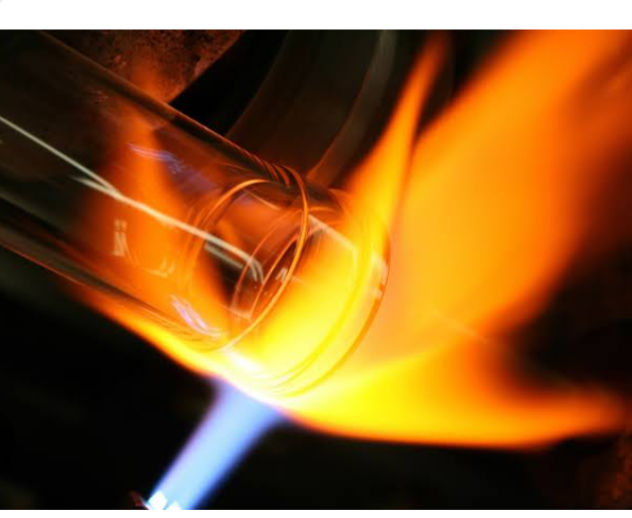
The primary thermal properties of soil, or any substance, are the heat capacity and the thermal conductivity.
Soil thermal regime influences the behaviour of the soil from agricultural and non agricultural stand point of view. It is a factor in determining :
1. Rate and direction of some soil physical properties
2. Energy and mass exchange with the atmosphere including evaporation and aeration
3. Types and rate of chemical reaction. For example weathering
4. It influences biological processes such as
a. Microbial activities such as Organic matter decomposition and mineralization of organic forms of nitrogen which increases with increase in temperature
b. Seed germination
c. Plant growth
Soil thermal regime depends on solar radiation received at the soil surface and soil thermal properties (volumetric heat capacity, thermal conductivity, and thermal diffusivity).
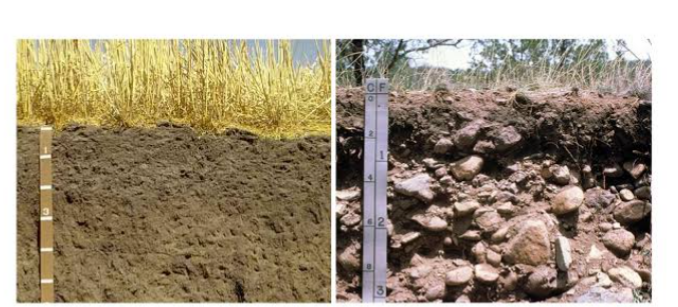
ASPECTS OF SOIL THERMAL REGIME
Some of the different aspect of soil thermal regime include: soil heat intensity, soil heat capacity and rate of movement of heat in the soil.
SOIL HEAT INTENSITY : The average kinetic energy of a given body of molecules is expressed as temperature measured in degree Celsius or kelvin ( °C or K). Heat intensity or temperature is a quantitative description of the primary sensation of hotness or coldness.
GAVIMETRIC HEAT CAPACITY: This is the amount of heat required to raise the temperature of a given mass of soil by 1 degree.
Mathematically,
C=Q/dT
Where
C= Gavimetric heat capacity in joules pee kelvin (J K-1) or calorie per degree Celsius (Cal °C-1)
Q= quantity of heat
T=temperature in kelvin
Also, gavimetric heat capacity can also be calculated thus,
Recall: Heat capacity=mass of soil in each component * specific heat of the components
C= Q/DT. , c =Q/dT/M
from these two above formulas, c can be deduced to be
c =C/M
C=Mc
C = M1c1 + M2c2 + Mncn
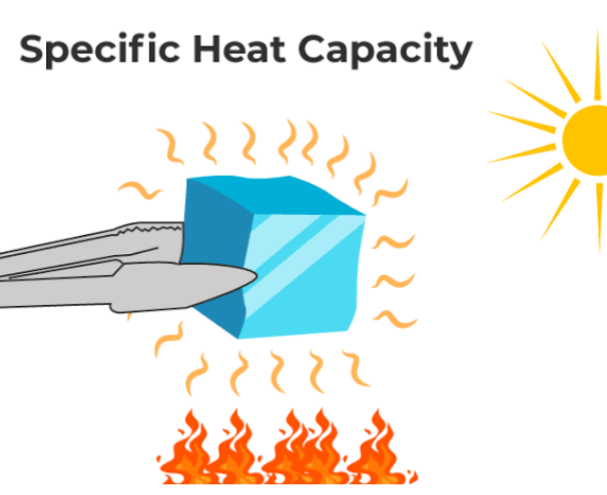
SPECIFIC HEAT: This is the amount of heat required to raise the temperature of a unit quantity of substance. For example, soil by 1 degree. Therefore, specific heat is denoted by
c =Q/dT/M (Jkg-1K-1 or Cal g-1 °C-1)
Where M is mass
THERMAL CONDUCTIVITY: This is the amount of heat transfered through a unit cross sectional area of unit thickness in unit time under unit temperature gradient. It is a measure of the soil’s ability to conduct heat, just as the hydraulic conductivity is a measure of the soil’s ability to “conduct” water. Soil thermal conductivity is influenced by a wide range of soil characteristics or geotechnical properties which include: air-filled porosity, water content, bulk density, texture, mineralogy, organic matter content, soil structure and soil temperature. The unit is (W m-1 °C-1)
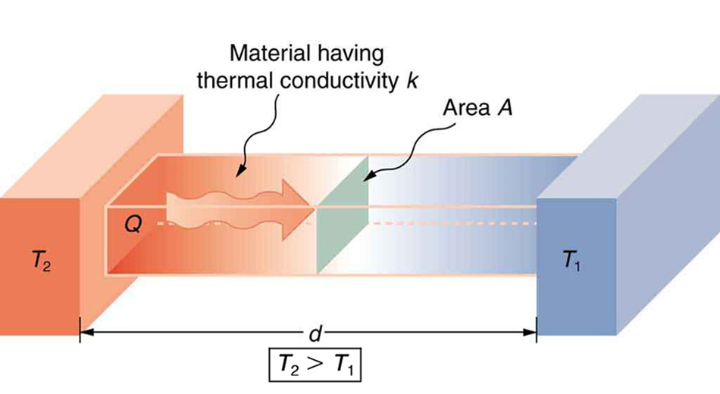
SOIL CHARACTERISTICS INFLUENCING THERMAL CONDUCTIVITY
a. Soil texture: When soils of different texture are tested under equal moisture content and densities, it will be discovered that the coarse grained materials like sand will have higher conductivity. Among all soil constituents, sandy soil that contain quartz has the highest thermal conductivity and air has the lowest thermal conductivity. Sandy soils have higher thermal conductivity values than other soils due to its quartz content. .
b. Air filled porosity: The thermal conductivity of air is very low. Therefore, air-filled porosity exerts a dominant influence on soil thermal conductivity. The higher the air-filled porosity, the lower the thermal conductivity.
c. Water content: Soil thermal conductivity increases as water content increases, but not in a purely linear fashion. For dry soil, relatively small increases in the water content can substantially increase the thermal contact between mineral particles because the water adheres to the particles, resulting in a relatively large increase in the thermal conductivity
d. Soil Temperature : More energy is required to increase the temperature of wetter, denser soil than to increase the temperature of drier, less dense soil, which has a lower volumetric heat capacity. Thermal conductivity increases dramatically with temperature in moist soil, reaching values 3 to 5 times the ambient value at 90°C. The modified de Vries theory agreed this. This is one factor that can contribute to lower soil temperature and delayed crop development in soils managed with no tillage.
e. Bulk Density : Excessive tillage do weakens the natural stability of soil aggregates making them susceptible to erosion caused by water and wind. When eroded soil particles fill pore space, porosity is reduced and bulk density increases. Soil k depends on bulk density (ρb) due to the heat transfer in the soil being dependent on the solid phase and mineral composition of the soil. k increases with soil depth due to the increase in soil ρb.
f. Organic Matter content: soils with high organic content has lowest conductivity. Higher organic matter content in the soil increases soil porosity which also decreases soil thermal conductivity especially when the soil pores are filled with air.
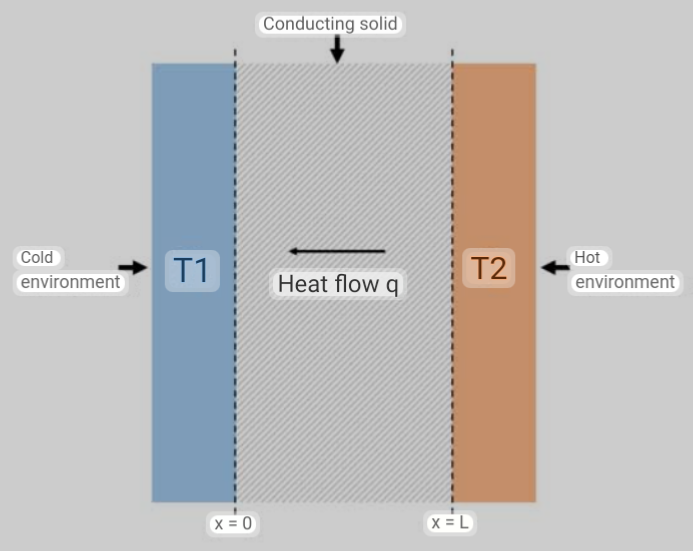
VOLUMETRIC HEAT CAPACITY: This is the change in heat content of a unit bulk volume of soil per unit change in temperature. It’s unit is (J m-3K-1 or Cal cm-3 °C-1). Or simply defined as the amount of energy required to raise the temperature of a unit volume of soil by one degree. Unlike thermal conductivity, volumetric heat capacity increases strictly linearly as soil water content increases. Volumetric heat capacity is also a linear function of bulk density.
The volumetric heat capacity depends on
a. Soil solid composition. That is, the mineral and organic constituent fraction of the soil. The mineral fraction include: sand, silt and clay
b. Density of each compositon
c. Soil wetness and
d. Temperature (frozen or un- frozen)

Therefore, the volumetric heat capacity of the soil may be obtained by summation of contribution of each components. That is, addition of the heat capacity of the various constituents weighed according to their volume fractions. That is,
C=£(fsCs + fwCw + faCa).
Where
£= summation
C= Volumetric heat capacity in J m-3 K-1 or Cal cm-3 °C-1
f= Volume fraction of each phase in m3 or cm3
Cs=ρbs*c*ms
Cw=ρbw*c*mw
Ca=ρba*c*ma
ρb = the soil bulk density (g cm-3)
c = specific heat
s, w, a means solid, water and air
Cs, Cw, and Ca are the volumetric heat capacities of solid, water and air content of soil respectively and this indicate production of respective density and specific heat per unit mass.
Since density of air is only 1 per 1000th, to that of water. It’s contribution to specific heat of composite soil can be generally neglected. Thus, the above equation can be simplified to
C= (fmCm + foCo + fwCw) /fsCs
fm, fo and fw represent volume fraction of minerals, organic matter and water
Cm, Co and Cw represent average specific heat capacities of mineral, organic matter and water respectively.
Also, volumetric heat capacity can also be calculated in relation with the volumetric water content using another formular.
The volumetric heat capacity can be calculated by
C= ρbcs + ρwcwθ
Where
C= volumetric heat capacity
ρb = the soil bulk density (g cm-3)
cs =is the specific heat of the soil solids (J g-1 °C-1)
ρw is the density of water (g cm-3)
cw is the specific heat of water, and
θ is the volumetric water content (cm3 cm-3).
THERMAL DIFFUSIVITY: This is the temperature change that takes place in a portion of a given soil as heat flow into it from adjacent layers. It is the diffusion of heat through the soil. It is an indicator of the rate at which a temperature change will be transmitted through the soil by conduction. When the thermal diffusivity is high, temperature changes are transmitted rapidly through the soil. Logically, soil thermal diffusivity is influenced by all the factors which influence thermal conductivity and heat capacity.
Thermal diffusivity compared to thermal conductivity and volumetric heat capacity is less sensitive to soil water content while the latter two are more sensitive to water content.
It is the ratio of the thermal conductivity to the volumetric heat capacity (m2 s-1).
Thermal diffusivity is the ratio of thermal conductivity to heat capacity or change in temperature in degree Celsius in 1 second when temperature gradient changes by 1 °C/cm
The thermal diffusivity is useful in understanding and modeling soil temperature.
Thermal diffusivity “D” =K/C
C= Heat capacity
K=Thermal conductivity
MEASUREMENT OF SOIL TEMPERATURE
Temperature is not measured directly, rather it is estimated by it’s influence on some properties of matter which are it’s responsiveness. Instruments built to take advantages of these properties are known as thermometer. The unit is °C or K.
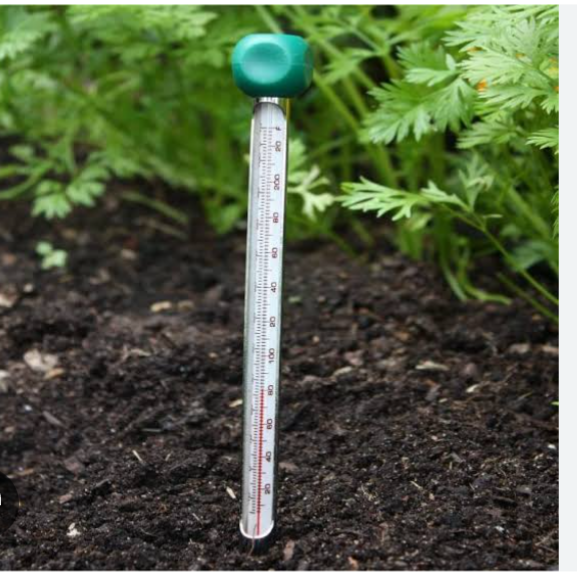
FACTORS INFLUENCING SOIL TEMPERATURE
This factor can be grouped into two
1: Factors that influence the amount of heat available at the soil surface
2: factors that influence dissipation of available heat
1. FACTORS THAT INFLUENCE THE AMOUNT OF HEAT AVAILABLE AT THE SOIL SURFACE
The main factors involved in soil heating are climatic ( for example, solar radiation, air temperature, air humidity, and wind speed), soil properties like soil colour, soil moisture content and photometric and physical characteristics of the mulch, cover materials and organic matter etc.
a. AMOUNT OF SOLAR RADIATION :It is the primary source of land heating. This is why ground warmth at different depths varies. The upper surface layers of the soil are usually warmer than the deep down the profile. Meaning the deeper the profile the cooler it becomes.
b.ORGANIC MATTER : It increases water retention and darkens the earth. From the albido property of soil stated in “c” above (reflectivity constant), organic matter content increases the temperature of the soil.
c. SOIL COLOUR : Soil colour has influence on albido (reflectivity constant). Physics also proves that darker objects absorb more sunlight than lighter or shinning objects, and the soil is no an exception. So, the darker soil, the faster it warms up.
d. SOIL MOISTURE :Wet grounds conduct heat vertically better than dry ones . It means dry soil heats up faster during the day and cools down faster at night.
e. SEASON AND ATMOSPHERIC CONDITIONS :. The distribution of solar energy depends on the season and the absence/presence of sunlight, clouds, and air warmth/coldness. Naturally, the warmer the day is, the warmer the soil becomes.
f. GROUND COVER :Bare lands heat up faster. When cover crops cover the soil surface, they prevent intercept the heat from the sun, preventing it from reaching the soil surface and thus also prevent evaporation thereby cooling the soil. Such cover materials include: mulch, cover crops, crop residue, vegetation canopy, etc.
g. DECOMPOSITION OF COMPOST AND MANURE :Decomposition is a chemical process carried out by microorganisms. During the decomposition process, heat is generated. Therefore, if compost and manure are added to the soil to decompose, the soil temperature raises.
h. ANGLE OF SLOPE : Solar radiation penetrates the ground more intensively when the angle is around 90 degrees and disseminates more if the field is on a hill. Terrace farming is a great agricultural practice to control the intensity of solar radiation on hilly farmlands. i. SOIL COMPOSITION AND TEXTURE : Clay usually has a higher heat capacity than sand, with equal water content and density . However, sand heats more quickly than clay due to the lower volume of water (lower porosity). Thus, thermal conductivity increases in finer particles soil.
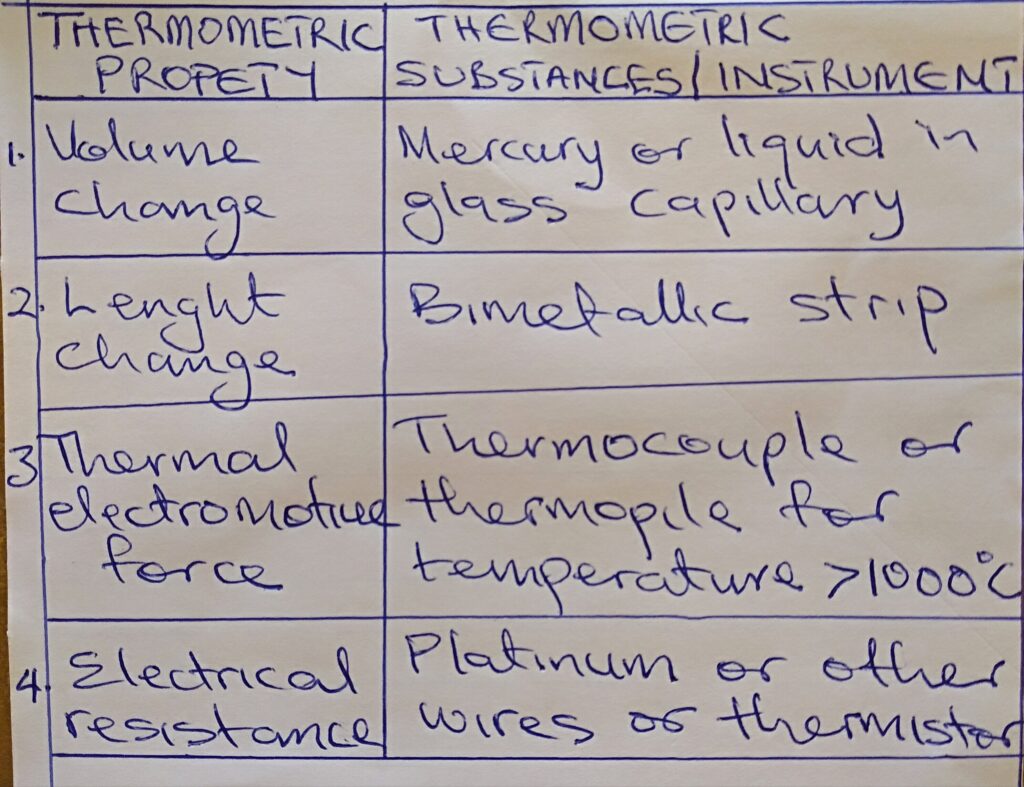
2: FACTORS THAT INFLUENCE DISSIPATION OF AVAILABLE HEAT
a. SOIL MOISTURE CONTENT : Moisture influences soil heat dissipation down the profile. The flow of heat is higher in a wet soil than in a dry soil where the pores are filled with air. The rate of heat dissipation increases with moisture content. Thus, influence thermal conductivity and heat capacity.
b. BULK DENSITY : High bulk density increases the soil surface by increases the amount of heat dissipated through the soil surface by increasing the rate at which heat energy passes through a unit cross-sectional area of the soil.
HEAT FLOW THROUGH THE SOIL
Mode of heat energy transfer in soil are: conduction, convection and radiation.
CONDUCTION involves flow of heat through matter unaccompanied by any motion of the matter order than molecular motion
CONVECTION involves flow of heat by moving matter which could be free or forced. For example, force by blowing heat
RADIATION is the process whereby energy is transmitted through space without the presence of matter. For example, electromagnetic radiation from sun.
In soil, the principal mode of heat transfer is conduction
THERMAL CONDUCTIVITY AND THE LAW OF FOURIER
Thermal conductivity follows the law of heat conduction known as Fourier’s law which state that the flux of heat in homogeneous body is in the direction of and proportional to the temperature gradient in one dimensional form.
qh = – Kx(dT/dx) — In this case, Movement is towards any direction. That is upward, downward, vertical right or left
qz= – Kz(dT/dz) — In this case, Movement is vertically downward
qh= – KxA(dT/dx)
Where
A= Area
q= heat flow through the surface of area A in J/sec
q is also equal to thermal flux
dT/dx= Temperature gradient
K= Thermal conductivity (Cal cm-1sec-1 °C-1)
q= – KA(dT/dx)
q= Q/At
K= (Q/At) *(dx/DT) with unit J m-1 sec-1 K-1 or Cal cm-1 sec-1°C-1
Q= quantity of heat passing through a unit cross sectional area per time.
For discrete values, negative is neglected.
FACTORS INFLUENCING THERMAL CONDUCTIVITY
Thermal conductivity is a function of :
a. Soil phase composition. That is, proportion of each phase either water, solid or air in the soil. It is also influenced by size and arrangement of soil particles.
b. Size and arrangement of solid particles. ( Ksand >loam >clay>peat). K deminishes with reduced particle size because of reduce surface contact between particles and through which heat will flow
c. Interphase relationship between solid and liquid phase. Soil moisture improves thermal contact and causes replacement of air with water.
TYPES OF VARIATION ( SOIL THERMAL VARIATION)
1. Diurnal
2. Seasonal
3. Variation with depth
DIURNAL: When solar radiation falls on the soil surface, it heats the soil causing a difference of temperature between surface soil and sub-soil. At day time, heat flows from surface soil to sub-soil and vice versa at night.Temperature changes with time of the day. Duirnal variation is affected by a variety of factors such as large bodies of water, soil type and cover, wind, cloud cover/water vapor, and moisture on the ground. Also, this variation in temperature affect evaporation of moisture.
SEASONAL VARIATION: Wet soil requires more energy to heat than dry soil. This influences seasonal changes in soil temperatures. Wet soils will take more energy to warm in the spring or raining period than dry soils.
VARIATION WITH DEPTH: This depend on the soil nature and locality. As depht increases, soil temperature also increases. Since the heat transfer rate of buried objects increases, the resistance to heat flow increases as the soil depth increases.
